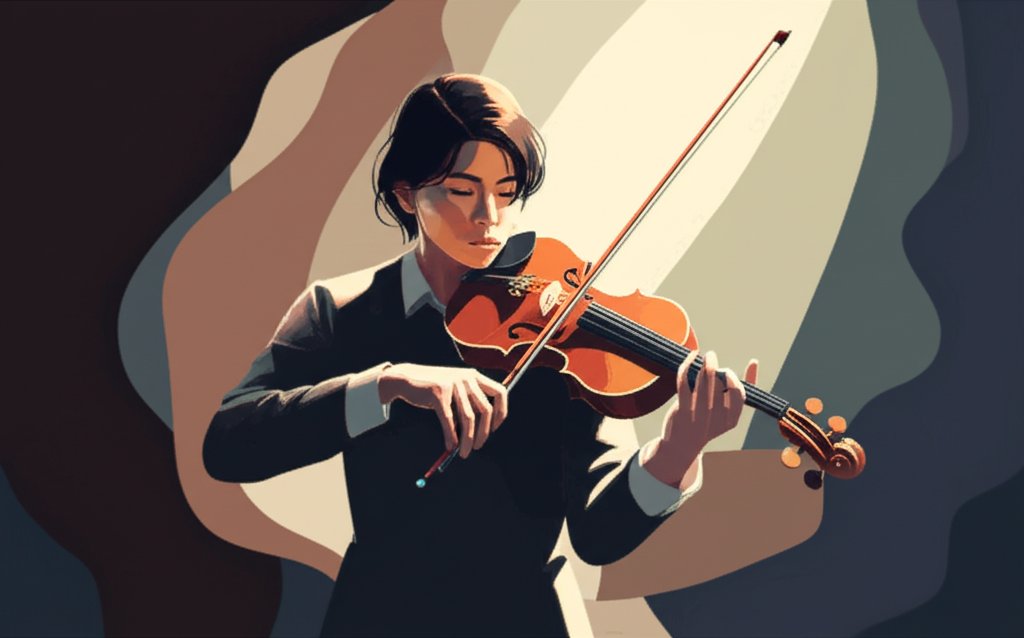The calendar for any aspiring concert violinist is a complex tapestry of deadlines, repertoire choices, and strategic planning. For many, the prospect of a major violin competition 2025 is both a thrilling goal and a daunting logistical puzzle. With events like the International Instrumental Competition in Markneukirchen drawing applicants from over 30 countries, the global stage is more competitive than ever. The key isn’t just to play well, but to prepare, plan, and execute with precision.
This is your focused guide to navigating the opportunities of 2025. We’ll move beyond general advice and dissect a real-world competition, transforming abstract goals into a concrete action plan.
At a Glance: Your 2025 Competition Strategy
- Deep Dive into a Key Event: We’ll use the 8th “VASCO ABADJIEV” International Violin Competition as a case study for understanding rules, repertoire, and timelines.
- Strategic Repertoire Selection: Learn how to break down multi-round requirements to showcase your unique strengths, from Bach to a final concerto performance.
- The Practical Playbook: Uncover a step-by-step timeline and budget for your application, ensuring you manage logistics as well as you manage your instrument.
- Common Questions Answered: Get direct answers to frequent concerns about choosing the right competition, managing pressure, and making a lasting impression.
- From Application to Podium: Gain clarity on the entire process, from submitting your entry fee to performing with an orchestra in the final round.
The 2025 Landscape: A Global Stage Reawakened
The international competition circuit is buzzing with energy. Events are not just returning; they’re expanding, offering young artists vital platforms to launch their careers. While our comprehensive Violin Competition Guide covers the titans like the Tchaikovsky and Queen Elisabeth competitions, 2025 also features a rich array of specialized events that provide unique opportunities.
One such event is the 8th “VASCO ABADJIEV” International Violin Competition, scheduled for November 20-23, 2025, in Sofia, Bulgaria. Hosted by Club UNESCO “Leonardo da Vinci” Sofia, it’s a perfect example of a competition that combines a prestigious jury, a significant prize purse, and a challenging repertoire designed to identify truly versatile artists. By dissecting its structure, we can create a blueprint you can adapt for almost any competition you target in the coming year.
A Case Study: The Vasco Abadjiev Competition 2025
Let’s treat this competition as our working model. Understanding its specific requirements provides a tangible framework for your own preparations.
Who Should Apply? Understanding the Eligibility
The first gate is always eligibility. For the Abadjiev competition, the rule is simple: applicants must be born after November 20, 1995. This targets violinists who are typically finishing their conservatory training or are in the early stages of a professional career.
If you fall into this age bracket, the next step is a frank self-assessment. Does your current repertoire align with the competition’s demands? Do you have the stamina for three intense rounds of performance? This is a crucial conversation to have with your teacher.
The Application Checklist: Beyond the Entry Form
A successful application is about meticulous organization. Don’t let a simple mistake on a form disqualify you before you even play a note.
- Deadline: Mark October 15, 2025, in your calendar. Work backward from this date.
- Fee: Prepare the 80 EUR (or 157 BGN) participation fee. International payments can sometimes be tricky, so don’t leave this to the last minute.
- Submission: The application is sent via email to
[email protected], with a carbon copy to[email protected]. - Your Pre-Submission Packet: Before you hit “send,” have these items ready:
- A completed application form (if provided).
- A high-quality headshot.
- A professional biography (usually 150-300 words).
- A scanned copy of your passport or ID to verify your birth date.
- Your complete, finalized repertoire list for all three rounds.
By the Numbers: Prizes and Recognition
While artistry is the goal, the prizes are a significant factor. They provide not only financial support but also a crucial line on a musician’s CV.
| Prize | Amount |
|---|---|
| First Prize | 3,000 EUR |
| Second Prize | 2,000 EUR |
| Third Prize | 1,000 EUR |
| Young Talent Award | 500 EUR |
| Beyond the cash, all participants receive a diploma of participation. For a young artist, simply being accepted into and performing at an international competition is a mark of achievement. |
Decoding the Repertoire: A Strategic Approach
The repertoire is the heart of any competition. The Abadjiev’s three-round structure is a classic format designed to test every facet of a violinist’s ability. Your choices here are the most important strategic decisions you will make.
Round 1: The Foundation of Technique and Style (Max. 30 min)
This round is about establishing your credentials. The jury is looking for clean technique, stylistic awareness, and musical intelligence.
- J.S. Bach: A movement from a solo sonata or partita. This is the ultimate test of intonation, structure, and musical purity. There’s nowhere to hide.
- Caprice/Etude: A choice from virtuosos like Paganini, Wieniawski, Ernst, or Vieuxtemps. This is your chance to showcase raw technical firepower and brilliance. Choose one that is not only difficult but that you can perform with flair and control under pressure.
- Mozart Concerto (1st Mvt.): The first movement of Violin Concerto No. 3, 4, or 5. This tests your understanding of the Classical style��elegance, clarity, and beautiful phrasing are paramount.
Pro-Tip: Your Round 1 program should be a balanced meal: the intellectual depth of Bach, the technical flash of a Caprice, and the refined elegance of Mozart.
Round 2: Demonstrating Depth and Virtuosity (Max. 40 min)
Here, the jury wants to see your personality and collaborative skills.
- Complete Sonata for Violin and Piano: Your choice of a sonata by Beethoven, Brahms, Schumann, Schubert, Franck, or Debussy. This is a test of partnership. You and your pianist must breathe together, shaping phrases as a single musical entity. Your choice reveals your musical taste and maturity.
- Virtuosic Work: A piece that showcases your command of the instrument. This is where you can let your personality shine, whether through fiery passion (Sarasate’s Carmen Fantasy) or breathtaking pyrotechnics (Ravel’s Tzigane).
Round 3: The Concerto Finale
This is the main event: performing with a symphony orchestra. The repertoire includes movements from the great romantic concertos by Beethoven, Brahms, Tchaikovsky, Sibelius, or Mendelssohn.
- The Challenge: Playing with an orchestra is a different skill set. You must learn to project over a large ensemble, listen intently, and collaborate with the conductor in real-time.
- The Choice: Select a concerto that you have lived with for years. It should feel like a second skin. Your choice should not only fit your technical abilities but also your musical temperament.
A final, crucial rule: All works, except the sonata with piano, must be performed from memory.
Your 2025 Competition Playbook: From Preparation to Performance
A year seems like a long time, but for competition preparation, it passes in a flash. A structured plan is non-negotiable.
Crafting Your Timeline (Working Backwards from November 2025)
- 10–12 Months Out (Now): Repertoire & Foundation
- With your teacher, finalize your repertoire for all rounds.
- Focus on the foundational technical work for your chosen pieces. This is the time for slow, methodical practice.
- Secure a dedicated collaborative pianist for your sonata and Round 3 preparation.
- 6–9 Months Out: Memorization & Deep Study
- Begin the serious work of memorization.
- Study the scores away from the instrument. Understand the harmonic structure and compositional intent. Listen to a wide range of recordings.
- 3–6 Months Out: Performance Practice
- Schedule mock performances for friends, family, and colleagues. Playing for an audience, no matter how small, is a different experience.
- Record yourself—both audio and video. The microphone and camera are unforgiving and will reveal weaknesses you might not hear in the practice room.
- 1–3 Months Out: Polishing & Logistics
- This is for final polishing, not learning notes.
- Book your flights and accommodation in Sofia.
- Confirm logistics with your collaborative pianist.
- Submit your application well before the October 15 deadline.
The Financial Realities: Budgeting for Success
Participating in an international competition is an investment. A clear budget prevents financial stress from affecting your performance.
- Application Fee: €80
- Travel: Flights to Sofia, Bulgaria (varies greatly by origin).
- Accommodation: Hotel or Airbnb for the duration of the competition (at least 4-5 nights).
- Collaborative Pianist Fees: This includes rehearsal time and performance. It can be a significant cost.
- Lessons & Coachings: Extra sessions with your teacher or a specialist in the months leading up.
- Food & Local Transport: Daily expenses.
A realistic budget might range from $1,500 to $4,000 USD, depending heavily on your travel costs and pianist arrangements.
Quick Answers: Navigating Common Competition Questions
Q: How many competitions should I apply for in 2025?
Focus on quality, not quantity. Applying for one or two competitions that are a perfect fit for your current repertoire and artistic level is far more effective than a scattergun approach. Each application requires immense focus and preparation.
Q: Is it worth entering a smaller competition like the Vasco Abadjiev?
Absolutely. These competitions are invaluable. The jury is often just as distinguished as at larger events, but the atmosphere can be more focused on musicianship. A prize or even a finalist position here is a powerful addition to your biography and can be a stepping stone to events like the Paganini or Queen Elisabeth.
Q: What’s the biggest mistake competitors make?
There are two common pitfalls. The first is choosing repertoire that is too difficult. It’s better to play a slightly less demanding piece flawlessly and musically than to struggle through a technical behemoth. The second is burnout. Pacing is everything. Don’t peak two weeks before the competition; structure your practice to arrive fresh, confident, and ready to perform your best.
Q: How do I handle the immense pressure and nerves?
Preparation is the best antidote to nerves. The more you have simulated the performance environment through mock run-throughs, the more comfortable you will feel on stage. Develop a pre-performance routine that helps you feel centered and focused—whether it’s breathing exercises, stretching, or quiet meditation. Remember, the jury wants you to succeed.
Your Next Move: Seizing the 2025 Opportunity
The path to a violin competition 2025 is a marathon, not a sprint. The deadlines on the calendar are not finish lines; they are waypoints in a long and rewarding journey of artistic development. The structure of an event like the Vasco Abadjiev competition provides the perfect framework for your growth over the next year.
Start today.
- Assess Your Fit: Review the repertoire and eligibility for the Abadjiev or another target competition. Is this the right challenge for you, right now?
- Mark Your Calendar: Set reminders for the application deadline (Oct 15, 2025) and the competition dates (Nov 20-23, 2025).
- Begin the Conversation: Sit down with your teacher to map out a detailed preparation timeline and finalize your program.
- Build Your Team: Start discussions with a collaborative pianist.
The coming year holds immense potential for young artists ready to take the stage. By combining world-class talent with meticulous, intelligent preparation, you can transform a date on the calendar into a defining moment in your career.
- Major Classical Music Competitions Identify Talent Across The Globe - November 10, 2025
- Cliburn Competition Winners Showcase Pianos Next Generation of Stars - November 9, 2025
- Van Cliburn Competition Winners Crowned Pianos Foremost Artists - November 8, 2025










